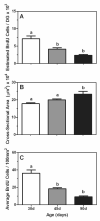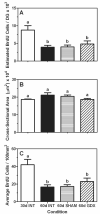The pubertal-related decline in cellular proliferation and neurogenesis in the dentate gyrus of male rats is independent of the pubertal rise in gonadal hormones
- PMID: 21990242
- PMCID: PMC3498080
- DOI: 10.1002/dneu.20987
The pubertal-related decline in cellular proliferation and neurogenesis in the dentate gyrus of male rats is independent of the pubertal rise in gonadal hormones
Abstract
Pubertal development is marked by significant decreases in cellular proliferation and neurogenesis in the dentate gyrus of the hippocampal formation. Although it is unclear what mediates these developmental changes in the dentate gyrus, gonadal hormones have been implicated in modulating many neurobiological processes during puberty and various parameters of neurogenesis in adulthood. Thus, it is possible that the gradual and sustained increase in gonadal hormones experienced during puberty plays a role in these changes in neurogenesis. In this experiments, we first quantified cellular proliferation and neurogenesis using 5-bromo-2'-deoxyuridine (BrdU) and doublecortin (DCX) immunohistochemistry, respectively, in the dentate gyrus of prepubertal (30 d), midpubertal (45 d), and adult (90 d) male rats. We found the decline in BrdU and DCX cell numbers throughout these ages was coincident with increases in their plasma testosterone levels. We next tested whether exposure to the pubertal rise in gonadal hormones was necessary for this decrease in hippocampal neurogenesis to occur. Thus, we examined cellular proliferation and neurogenesis in intact 30 day (prepubertal) and 60-day-old (late-pubertal) rats, as well as 60-day-old rats that had previously been gonadectomized or sham-gonadectomized at 30 days of age. Although we again found the expected decline in BrdU and DCX cell numbers between 30 and 60 days of age in the intact groups, there were no differences among the 60-day-old animals, regardless of gonadal status. These data indicate that the pubertal-related decline in hippocampal cellular proliferation and neurogenesis is independent of the pubertal change in gonadal hormones.
Copyright © 2011 Wiley Periodicals, Inc.
Figures






Similar articles
-
Testosterone and social isolation influence adult neurogenesis in the dentate gyrus of male rats.Neuroscience. 2011 Nov 10;195:180-90. doi: 10.1016/j.neuroscience.2011.08.034. Epub 2011 Aug 19. Neuroscience. 2011. PMID: 21875652 Free PMC article.
-
Gonadal hormone modulation of neurogenesis in the dentate gyrus of adult male and female rodents.Brain Res Rev. 2008 Mar;57(2):332-41. doi: 10.1016/j.brainresrev.2007.05.008. Epub 2007 Jun 9. Brain Res Rev. 2008. PMID: 17669502
-
Testosterone and dihydrotestosterone, but not estradiol, enhance survival of new hippocampal neurons in adult male rats.Dev Neurobiol. 2007 Sep 1;67(10):1321-33. doi: 10.1002/dneu.20457. Dev Neurobiol. 2007. PMID: 17638384
-
Gonadal hormone modulation of hippocampal neurogenesis in the adult.Hippocampus. 2006;16(3):225-32. doi: 10.1002/hipo.20154. Hippocampus. 2006. PMID: 16411182 Review.
-
Adult neurogenesis in the mammalian dentate gyrus.Anat Histol Embryol. 2020 Jan;49(1):3-16. doi: 10.1111/ahe.12496. Epub 2019 Sep 30. Anat Histol Embryol. 2020. PMID: 31568602 Review.
Cited by
-
The role of puberty on physical and brain development: A longitudinal study in male Rhesus Macaques.Dev Cogn Neurosci. 2023 Apr;60:101237. doi: 10.1016/j.dcn.2023.101237. Epub 2023 Mar 22. Dev Cogn Neurosci. 2023. PMID: 37031512 Free PMC article.
-
Prepubertal gonadectomy reveals sex differences in approach-avoidance behavior in adult mice.Horm Behav. 2020 Feb;118:104641. doi: 10.1016/j.yhbeh.2019.104641. Epub 2019 Nov 29. Horm Behav. 2020. PMID: 31778717 Free PMC article.
-
The effect of adolescent testosterone on hippocampal BDNF and TrkB mRNA expression: relationship with cell proliferation.BMC Neurosci. 2015 Feb 18;16:4. doi: 10.1186/s12868-015-0142-x. BMC Neurosci. 2015. PMID: 25886766 Free PMC article.
-
Adolescent Changes in Cellular Proliferation in the Dentate Gyrus of Male and Female C57BL/6N Mice Are Resilient to Chronic Oral Corticosterone Treatments.Front Behav Neurosci. 2018 Aug 24;12:192. doi: 10.3389/fnbeh.2018.00192. eCollection 2018. Front Behav Neurosci. 2018. PMID: 30197591 Free PMC article.
-
Testosterone and Adult Neurogenesis.Biomolecules. 2020 Feb 3;10(2):225. doi: 10.3390/biom10020225. Biomolecules. 2020. PMID: 32028656 Free PMC article. Review.
References
-
- Andersen SL, Thompson RF, Krenzel E, Teicher MH. Pubertal changes in gonadal hormones do not underlie adolescent dopamine receptor overproduction. Psychoneuroendocrinology. 2002;27:683–691. - PubMed
-
- Barker JM, Galea LAM. Repeated estradiol administration alters different aspects of neurogenesis and cell death in the hippocampus of female, but not male, rats. Neuroscience. 2008;152:888–902. - PubMed
-
- Buwalda B, van der Borght K, Koolhaas JM, McEwen BS. Testosterone decrease does not play a major role in the suppression of hippocampal cell proliferation following social defeat stress in rats. Physiol Behav. 2010;101:719–725. - PubMed
Publication types
MeSH terms
Substances
Grants and funding
LinkOut - more resources
Full Text Sources
Other Literature Sources

